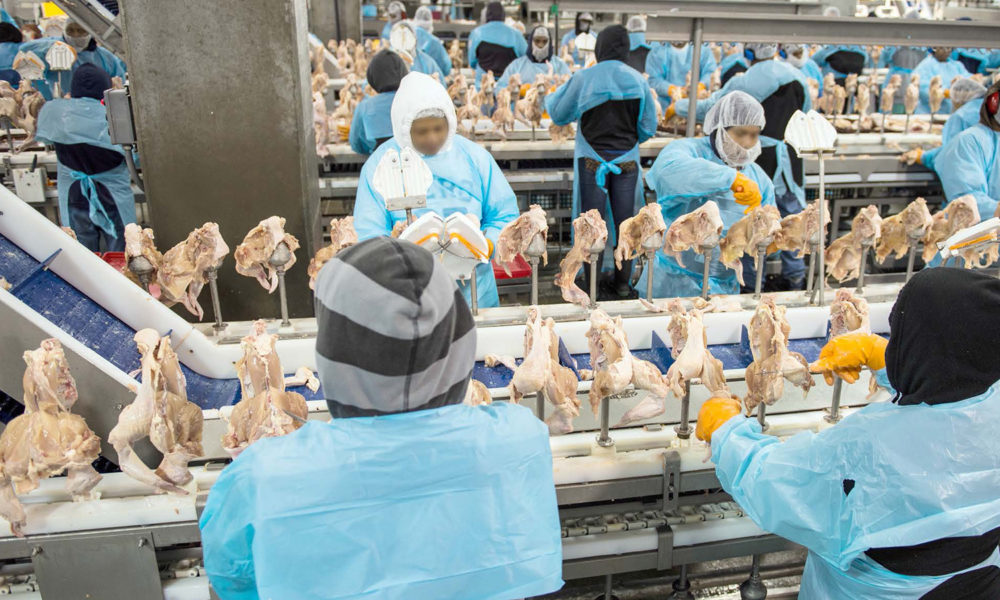Bowing to industry’s wishes, the US Department of Agriculture (USDA) wants to change regulations in a way that will compromise food safety and further endanger the lives of poultry plant workers across the nation. The agency’s Food Safety and Inspection Service (FSIS) is poised to propose a rule that will increase the maximum line speeds for processing poultry from 140 birds per minute (bpm) to 175 bpm. In 2018, FSIS had previously codified a process allowing them to grant some poultry companies faster line speeds during the height of the pandemic. But this new rule would go further. It would make this change permanent.
While there is no timeline yet on when the proposed rule will be officially announced, evidence suggests it will compromise worker safety at a time when poultry workers are already facing additional health and safety risks due to COVID-19. The issue at stake is line speeds, how fast poultry workers are able to process raw chicken or turkey carcasses along a conveyor belt. The work, which involves quickly cutting bone, tissue, and sinew with extremely sharp blades, was dangerous even before the pandemic, leading to a slew of workplace injuries.
Scientists, worker advocates, and food safety experts have long voiced serious concerns with ramping up line speeds at meat processing plants, since a body of scientific evidence suggests that there is a high risk of repetitive injuries for workers. Data from Occupational Safety and Health Administration (OSHA) in 2013 showed that poultry workers had carpal tunnel syndrome at rates more than seven times the national average and that poultry workers were 4.5 times more likely to identify repetitive motion as the exposure causing serious injury. Workers with such injuries have needed a day or more away from work, or have been placed on restricted activity so they can recuperate. The academic literature corroborates these findings by identifying high rates of carpel tunnel syndrome in poultry workers (see the following PubMed pages, here, here, and here). Faster line speeds may also endanger food safety inspectors and make it harder to prevent and detect contamination of carcasses.
COVID-19 is exacerbating these current health disparities
Workers at poultry plants usually come from low-income, Latinx communities, and represent one of the most marginalized groups in the country. Workers at poultry plants face low wages, are reluctant to speak up about hazardous working conditions, and are routinely denied adequate bathroom breaks.
These stark inequities have only been exacerbated during the COVID-19 era, where workers at pork and poultry plants are being pushed back to work by the federal government but face enormous risks of contracting COVID-19 while on the job. Many of the meat plants have become the sources of COVID-19 outbreaks in communities across the country, in places like Iowa, Arkansas, and Virginia. The CDC reported that in April to May 2020, over 16,000 COVID-19 cases occurred in meat and poultry processing facilities, of which 87 percent were workers of color.
Previously, FSIS used its waiver power to allow 15 large poultry plants to increase their line speeds during the pandemic, despite the fact that all the plants have a record of severe injuries (such as amputations), received safety violations from OSHA, or were the site of a COVID-19 outbreak. Increased line speeds almost inevitably require workers to work closer together, making it more difficult to adhere to social distancing guidelines recommended by the CDC to stop the spread of the novel coronavirus.
This action is without scientific merit
The agency has previously justified increased line speeds based solely on a pilot program, in which 20 chicken plants were allowed to increase their line speeds to 175 bpm. So far these pilot programs have failed to demonstrate viability and safety through objective and statistical evaluations. According to a previous FSIS inspector who was charged with evaluating the effectiveness of the pilot program, the plants repeatedly failed to prevent incidents of visible fecal contamination of the poultry products. The Government Accountability Office (GAO), a non-partisan agency that reports to Congress, raised concerns over this pilot program as early as 2001 and 2013. The GAO identified key limitations in the data collection and analyses used by FSIS to evaluate food safety, food quality, and the prevalence of Salmonella at the participating poultry plants. Bottom line, increased line speeds are bad for workers and for the safety of the chicken supply.
Pork manufacturing plants have faced similar work and food safety issues and have also seen these protections rolled back. In 2019, FSIS eliminated limits on line speeds for pork plants and reduced the number of food inspectors, allowing industry to self-police food safety. The USDA’s Office of Inspector General later concluded that this rulemaking process had used flawed and questionable data practices which made it impossible for outside experts to properly evaluate the agency’s decision.
The poultry industry is highly influencing the process
The poultry industry has played a major part in influencing FSIS to increase line speeds. The policy originates from a September 2017 petition by the National Chicken Council, a poultry industry lobbying group which wanted to eliminate all line speed regulations at poultry plants. While this petition was ultimately scraped by FSIS, particularly in response to the 100,000 comments on the proposal, it opened the door for FSIS to propose a waiver system to allow some poultry plants to increase to 175 bpm.
Unsurprisingly, this push by the poultry industry is driven by profits (or, as they put it in the petition, to level “the playing field within the U.S. chicken industry [and eliminate] competitive barriers between the U.S. and international chicken producers”). And during the pandemic, with a down economy and a reduced demand for food at restaurants, the poultry industry may be even more motivated to influence the USDA for their own ends.
Recently, the USDA announced 10 new members of a federal advisory committee on meat and poultry inspection and some of the members have conflicts of interest that are tied to industry. Three of the 20 members of the National Advisory Committee on Meat and Poultry Inspection have either directly worked for or were paid advocates for industrial-scale meat production.
Conclusion
By trying to enact a policy that is not firmly based on scientific evidence, FSIS is endangering the health, well-being, and lives of thousands of workers from marginalized communities and is potentially compromising the very safety of our food.
This is unacceptable. We need our governmental agencies to do better, to follow the science and carry out their duties to protect the health and safety of people, particularly those from the most vulnerable communities.

